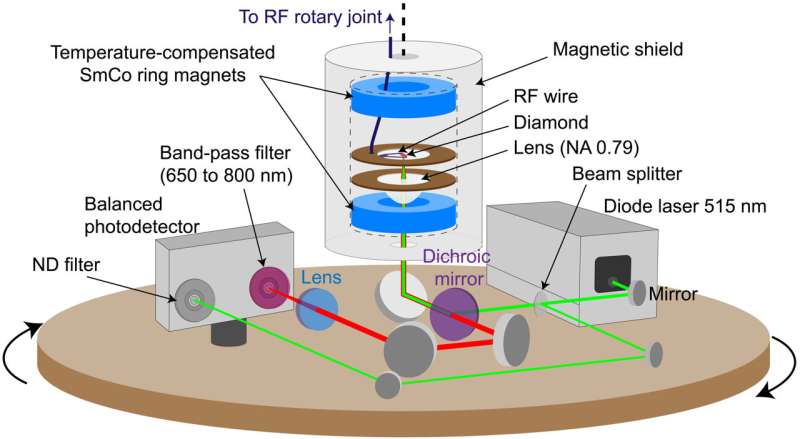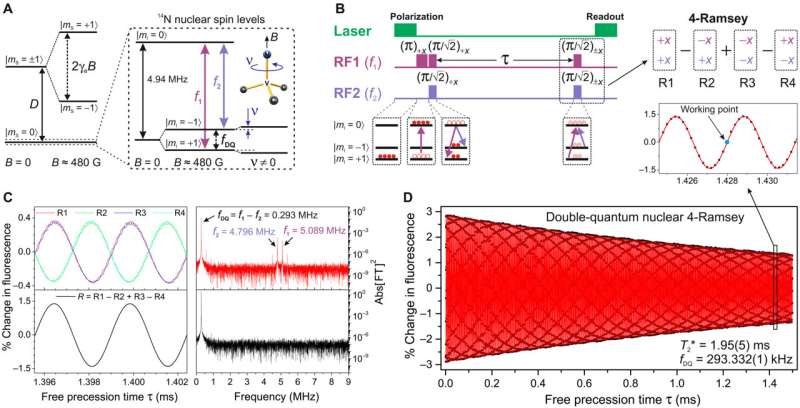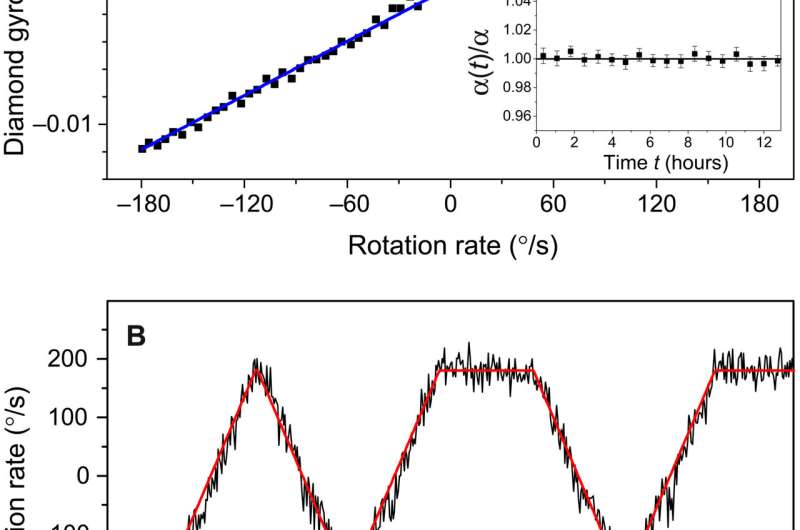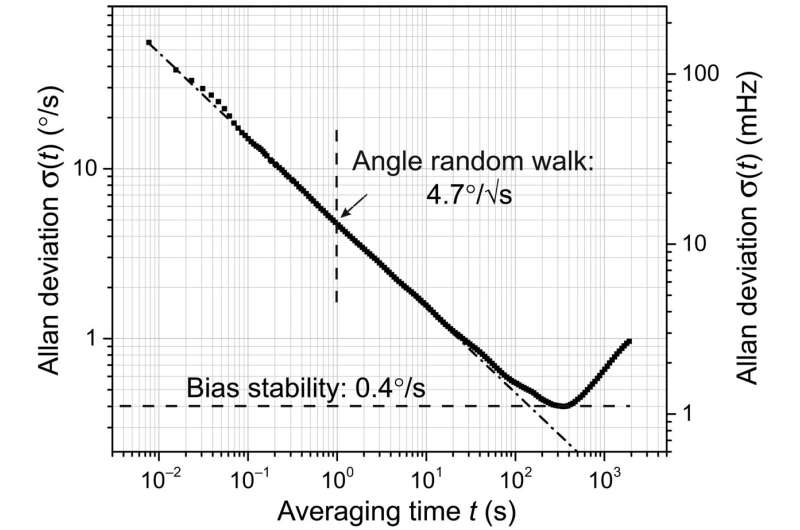Experimental setup. Electrical connections for the laser and the photodetector are wired to the rotating platform through slip-ring lines. RF signals are delivered to the platform via a single-channel RF rotary joint. NA, numerical aperture. ND, neutral density. Credit: Science Advances, doi: 10.1126/sciadv.abl3840
In a new report now published in Science Advances, Andrey Jarmola and an international research team in physics and materials in the U.S. and Germany demonstrated the function of a rotation sensor based on the Nitrogen-14 (14N) nuclear spins intrinsic to nitrogen-vacancy color centers in diamond. Nitrogen vacancy color centers are formed by nitrogen impurities that sit next to a missing carbon in diamond. The sensor used optical polarization and readout of the nuclei and a radiofrequency double-quantum pulse protocol to monitor the 14N nuclear spin precession. Rotation sensors or gyroscopes are typically used for navigation and automotive guidance. Among commercial sensors including mechanical gyroscopes and microelectromechanical systems, emerging techniques include nuclear magnetic resonance (NMR) gyroscopes. These sensors can surpass commercial devices within the next decade relative to accuracy, robustness and miniaturization.
A diamond sensor
Nuclear spin gyroscopes are based on nitrogen-vacancy (NV) color centers in diamond and are analogs of vapor-based NMR devices capable of functioning across a broad range of environmental conditions. A diamond sensor can function as a multi-sensor to report on magnetic field, temperature and strain, while serving as a frequency reference, suited for challenging environments. Jarmola et al. showed how a diamond NMR gyroscope directly provided information about the nuclear spin states without requiring precise knowledge of electron spin transition frequencies that are susceptible to environmental influences. With further improvements to the device, the team expect practical applications of miniature diamond gyroscopes during navigation.
Experimental setup
In the experimental setup, the team mounted the diamond sensor, green diode laser, photodetector and all optical components on a rotating platform regulated with a commercial rate table system. The diamond maintained a 400-µm thick single crystal plate with a nitrogen vacancy concentration of 4 parts per million. They produced the biased magnetic field using two temperature-compensated samarium-cobalt ring magnets. Jarmola et al. used an aspheric condenser lens to illuminate a 50 µm diameter on the diamond with an 80 mW green laser light to collect nitrogen vacancy fluorescence. The scientists spectrally filtered the fluorescence with a band-pass filter and focused it onto one of the channels of a balanced photodetector for photodetection. They then delivered radiofrequency pulses for nuclear spin control using a 160 µm diameter copper wire placed on the diamond surface next to the optical focus. To prevent ambient magnetic field noises, the team placed the setup including the diamond and magnets inside low-carbon-steel magnetic shields.
-
DQ measurement protocol using 14N nuclear spins in diamond. (A) Energy-level diagram of the NV center ground state with and without a magnetic field B applied along the NV axis. The inset depicts the 14N nuclear spin levels, where the splitting between the ∣mI = ±1⟩ sublevels depends on the applied field and on the rotation of the sample around the NV axis. Rotation sensing is based on the measurement of this interval. (B) DQ nuclear Ramsey pulse sequence. Inset: 4-Ramsey phase cycling measurement scheme. (C) DQ nuclear Ramsey fringes (R1, R2, R3, and R4) obtained by sequentially alternating phases of the last double quantum pulse as depicted in the inset of (B). The frequency-domain spectrum shows the square of the absolute value of the Fourier transform, which reveals DQ signal at fDQ frequency and residual single-quantum (SQ) signals at f1 and f2 frequencies. Bottom left: DQ nuclear 4-Ramsey fringes obtained by combining four DQ sequential Ramsey measurements R = R1 − R2 + R3 − R4 to cancel residual SQ signals. (D) DQ nuclear 4-Ramsey fringes. Symbols represent experimental data, while the solid line is an exponentially decaying sine wave fit. The oscillation frequency of the signal corresponds to the fDQ, while an exponential decay time corresponds to the nuclear DQ spin coherence time T∗2= 1.95(5) ms. Inset: Zoomed plot of DQ 4-Ramsey fringes near the working point; rotation measurements were performed at a fixed free precession time τ ≈ 1.4 ms by monitoring changes in the fluorescence signal. Credit: Science Advances, doi: 10.1126/sciadv.abl3840
-
Diamond gyroscope: Rotation sensing. (A) Diamond gyroscope fluorescence signal R measured as a function of the rotation rate of the platform (average of 15 traces; 200 s per trace). The calibration coefficient α is determined from the linear fit. Inset: Time stability of α. Fractional change in α is measured over several hours. (B) The rotation rates both measured by the diamond gyroscope and reported by the rate table are averaged over each second and then plotted together as a function of time. The time dependence is programmed to trace “NV.” Credit: Science Advances, doi: 10.1126/sciadv.abl3840
Rotation detection principle and practical applications of the gyroscope
To detect rotation, the team measured the shift in the precession state of 14N nuclear spins intrinsic to nitrogen vacancy centers in diamond. The scientists prepared the 14N nuclear spins in a superposition state. They then achieved the rotation detection presented in the work by measuring the frequency shifts with a Ramsey interferometry technique. To demonstrate the practical implications of the diamond gyroscope across a range of rotation rates, the scientists performed a series of test experiments on a rate table. To begin with, they calibrated the gyroscope and then converted the fluorescence signal into a calibration rotation signal.
Diamond gyroscope: Allan deviation. Diamond gyroscope noise measurement as a function of averaging time. The diagonal dash-dotted line shows a 1/t√ dependence consistent with a white frequency noise. Credit: Science Advances, doi: 10.1126/sciadv.abl3840
Outlook
In this way, Andrey Jarmola and colleagues developed a solid-state NMR gyroscope based on 14N nuclear spins intrinsic to nitrogen vacancy (NV) centers in diamond. Jarmola et al. noted the key features of the technique including optical polarization and readouts of the nuclear spins without using microwave transitions. By using temperature-compensated magnets, magnetic shielding and robust pulse protocols, the team reduced the influence of temperature and magnetic field drift to extend the long-term stability of the gyroscope to hundreds of seconds. The team intend to improve the sensitivity of the diamond gyroscope by extending the 14N nuclear spin coherence time. To improve the long-term stability, they also propose to reduce the ambient magnetic field drifts with better magnetic shielding.
More information: Andrey Jarmola et al, Demonstration of diamond nuclear spin gyroscope, Science Advances (2021). DOI: 10.1126/sciadv.abl3840
J. S. Hodges et al, Timekeeping with electron spin states in diamond, Physical Review A (2013). DOI: 10.1103/PhysRevA.87.032118
Journal information: Science Advances , Physical Review A
© 2021 Science X Network


























